英语学术论文
八、英语学术论文特点

8.2.2 作者姓名和单位 (Author and Place of Employment) ★这一项属于论文署名问题。署名一是为了表明文责自负,二是记录作用的 劳动成果,三是便于读者与作者的联系及文献检索 (作者索引)。 ★ 大致分为二种情形,即:单个作者论文和多作者论文。后者按署名顺序 列为第一作者、第二作者等等。重要的是坚持实事求是的态度,对研究 工作与论文撰写实际贡献最大的列为第一作者,贡献次之的,列为第二 作者,余类推。注明作者所在单位同样是为了便于读者与作者的联系 ★ 例如: M. Mandal, T.K. Naskar
★
8.2.4 关键词(Key words)
★ 关键词属于主题词中的一类。主题词除关键词外,还包含有单元词、 标题词的叙词。主题词是用来描述文献资料主题和给出检索文献资料 的一种新型的情报检索语言词汇,正是由于它的出现和发展,才使得 情报检索计算机化 (计算机检索)成为可能。 ★ 例如: Keywords: Classical splines; B-splines; Control points; Optimization; Genetic algorithm
的可能的关键点和方向。
8.2.8 致谢(Acknowledgment) 按照 GB7713-87 的规定,致谢语句可以放在正文后,体现对下列方 面致谢:国家科学基金、资助研究工作的奖学金基金、合同单位、资 助和支持的企业、组织或个人;协助完成研究工作和提供便利条件的 组织或个人;在研究工作中提出建议和提供帮助的人;给予转载和引 用权的资料、图片、文献、研究思想和设想的所有者;其他应感谢的 组织和人。
8.1.2 研究综述(Overview)
★ 综述是指就某一时间内,作者针对某一专题,对大量原始研究论文中 的数据、资料和主要观点进行归纳整理、分析提炼而写成的论文。 ★ 综述不是对以往研究成果简单的介绍与罗列,而是经作者精心阅读后 ,系统地总结某一研究领域在某一阶段的进展情况,并结合具体情况 和实际需要提出自己见解的一种科研工作。 ★ 研究综述的意义: 1、为新课题的最后确立提供了强有力的论据,为研究者今后的研究工 作指明了方向; 2、节省时间和精力。 例文:HIV Drug Resistance
高二英语英语学术论文写作单选题30题答案解析版

高二英语英语学术论文写作单选题30题答案解析版1.In academic writing, it is important to be _______ in presenting your arguments.A.preciseB.vagueC.casualD.hasty答案:A。
在学术写作中,精确地呈现你的论点很重要。
选项B“vague”( 模糊的)不符合学术写作要求;选项C“casual”( 随意的)和选项D“hasty” 匆忙的)也不适合学术写作的严谨性。
2.When writing an academic paper, you should avoid using _______ language.A.colloquialB.formalC.technicalD.sophisticated答案:A。
写学术论文时,应避免使用口语化的语言。
选项B“formal”正式的)、选项C“technical”专业的)和选项D“sophisticated”(复杂的)在学术写作中有其特定用途,而口语化语言不适合学术写作。
3.A good academic paper is characterized by its _______ analysis.A.superficialB.thoroughC.hastyD.cursory答案:B。
一篇好的学术论文以其全面的分析为特点。
选项A“superficial”( 肤浅的)、选项C“hasty”( 匆忙的)和选项D“cursory” 粗略的)都不能体现学术论文的高质量分析。
4.In academic writing, you should use _______ sources to support your arguments.A.reliableB.dubiousC.unreliableD.questionable答案:A。
在学术写作中,你应该使用可靠的来源来支持你的论点。
英文学术论文范文
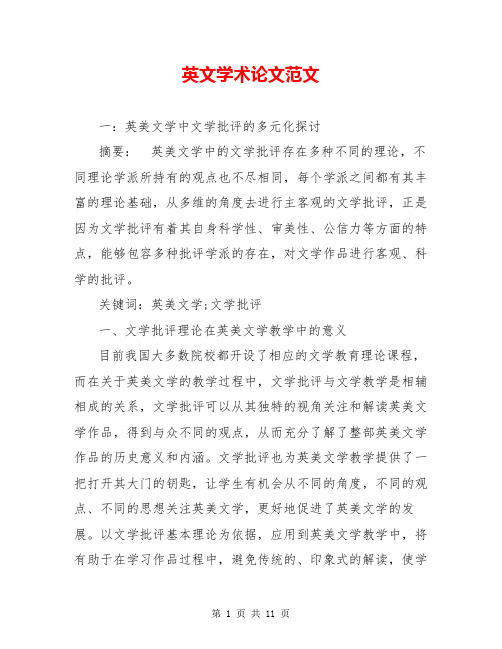
英文学术论文范文一:英美文学中文学批评的多元化探讨摘要:英美文学中的文学批评存在多种不同的理论,不同理论学派所持有的观点也不尽相同,每个学派之间都有其丰富的理论基础,从多维的角度去进行主客观的文学批评,正是因为文学批评有着其自身科学性、审美性、公信力等方面的特点,能够包容多种批评学派的存在,对文学作品进行客观、科学的批评。
关键词:英美文学;文学批评一、文学批评理论在英美文学教学中的意义目前我国大多数院校都开设了相应的文学教育理论课程,而在关于英美文学的教学过程中,文学批评与文学教学是相辅相成的关系,文学批评可以从其独特的视角关注和解读英美文学作品,得到与众不同的观点,从而充分了解了整部英美文学作品的历史意义和内涵。
文学批评也为英美文学教学提供了一把打开其大门的钥匙,让学生有机会从不同的角度,不同的观点、不同的思想关注英美文学,更好地促进了英美文学的发展。
以文学批评基本理论为依据,应用到英美文学教学中,将有助于在学习作品过程中,避免传统的、印象式的解读,使学生通过对原著的充分解读,仔细品味原著中作者想要表达的观点,以及写作的手法,培养学生踏实阅读的学风,还能够让学生充分感受到文学的魅力,增强学习兴趣,提高学习成绩。
二、英美文学中文学批评的多方位表现形式1.英美文学中新批评理论。
上世纪三四十年代开始出现以兰色姆(J.C.Ransom,1888-1974)、威姆塞特(W.K.Wimsatt,1907-1975)等为代表,形成了英美文学中的新批评理论。
他们认为一切从作者的原始写作动机与作者的阅读感受为出发点所进行的文学批评都是错误的谬论,脱离了文学批评的初衷,将文学批评的对象进行了根本的转移,即转移到了文学作品对阅读者心理影响方面上,脱离了被批评对象的本身,从而沦为了单一的印象论。
英美文学中的新批评理论认为单纯依靠阅读者的感觉,会使阅读者产生相对的阅读错觉即带入阅读者已有的自我认知来干扰对作品进行正确的、客观的文学批评。
高二英语英语学术论文写作练习题30题

高二英语英语学术论文写作练习题30题1.In academic writing, which is a better way to start an essay?A.Starting with a quote.B.Starting with a question.C.Starting with a definition.D.Starting with a personal story.答案:B。
解析:在学术写作中,以问题开头可以引起读者的兴趣,促使他们思考并继续阅读以寻找答案。
以引用开头可能会显得比较生硬,且不一定能直接引出主题。
以定义开头可能会比较枯燥。
以个人故事开头在学术写作中不太恰当,不够客观。
开头部分很重要,它决定了读者是否有兴趣继续阅读下去。
以问题开头的优点是能激发读者的好奇心,缺点是如果问题不够有吸引力,可能效果不佳。
2.When introducing a topic in an academic paper, what should you avoid?A.Being too general.B.Being too specific.ing complex language.ing simple language.答案:A。
解析:在引入主题时,应避免过于笼统。
过于笼统会让读者不清楚文章的具体焦点。
过于具体可能在开头不太合适,但不是应该避免的。
使用复杂语言和简单语言都可以,只要恰当运用。
开头部分需要明确主题,避免过于宽泛,让读者能快速了解文章的大致方向。
以具体而清晰的方式引入主题的优点是能让读者迅速抓住重点,缺点是可能会限制文章的拓展性。
3.Which of the following is a good way to pose a problem at the beginning of an academic essay?ing a rhetorical question.B.Listing all the possible solutions.C.Describing the consequences of the problem.D.Giving a historical background of the problem.答案:A。
英文学术论文范文英文学术论文范文范例(优秀7篇)
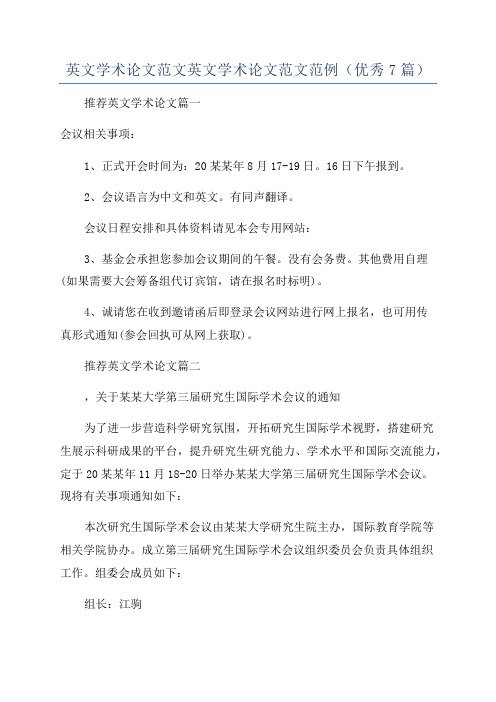
英文学术论文范文英文学术论文范文范例(优秀7篇)推荐英文学术论文篇一会议相关事项:1、正式开会时间为:20某某年8月17-19日。
16日下午报到。
2、会议语言为中文和英文。
有同声翻译。
会议日程安排和具体资料请见本会专用网站:3、基金会承担您参加会议期间的午餐。
没有会务费。
其他费用自理(如果需要大会筹备组代订宾馆,请在报名时标明)。
4、诚请您在收到邀请函后即登录会议网站进行网上报名,也可用传真形式通知(参会回执可从网上获取)。
推荐英文学术论文篇二,关于某某大学第三届研究生国际学术会议的通知为了进一步营造科学研究氛围,开拓研究生国际学术视野,搭建研究生展示科研成果的平台,提升研究生研究能力、学术水平和国际交流能力,定于20某某年11月18-20日举办某某大学第三届研究生国际学术会议。
现将有关事项通知如下:本次研究生国际学术会议由某某大学研究生院主办,国际教育学院等相关学院协办。
成立第三届研究生国际学术会议组织委员会负责具体组织工作。
组委会成员如下:组长:江驹副组长:刘丽琳范祥涛王亚彤成员:沈星黄金泉赖际舟刘少斌左敦稳汪涛葛红娟刘友文张卓李栗燕屈雅红刘长江于敏王箭秘书:张廷赟沈楠郑珺子20某某年11月18日-20日中国某某某某大学㈠征稿范围本次国际学术会议征稿对象为某某大学硕、博士研究生(含留学生)、国内其他高校硕、博士研究生(含留学生)、国外研究生。
㈡投稿时间国外研究生投稿时间为20某某年6月10日-8月31日国内研究生(含留学研究生)投稿时间为20某某年6月10日-10月1日。
㈢投稿要求1、本次学术会议论文投稿领域分航空宇航、机械、信息、材料、人文经管、其他共六大类。
论文要求为原创研究成果,论文内容不涉密、不涉及政治与宗教问题。
2、本次学术会议以研究生提交英文论文、大会英文发言交流形式参会。
所有未正式发表的论文均可投稿,长度不限。
㈣评审时间1、会议形式本次会议官方用语为英语,会议分大会交流和分组交流,组委会将选出不超过10篇论文参加大会英文发言交流,其余所有录用论文将在分会场进行交流发言。
英语学术论文范文

英语学术论文范文英语学术论文是国际学术交流中最常见的形式之一。
在撰写英语学术论文时,需要遵循一定的规范和格式,以确保文章的准确性和可读性。
本文将为大家提供一篇英语学术论文范文,以供参考。
AbstractThis paper aims to investigate the impact of social media on consumer behavior in the fashion industry. Through a literature review and a survey of 200 participants, the study found that social media has a significant influenceon consumers’ purchasing dec isions, particularly in the areas of brand awareness, product information, and social influence. The study also suggests that fashion brands should leverage social media platforms to engage with consumers and build brand loyalty.IntroductionThe rise of social media has transformed the way people communicate, interact, and consume information. In recent years, social media has become an increasingly important tool for businesses to reach and engage with consumers. The fashion industry, in particular, has been quick to embrace social media as a means of promoting their products and building brand awareness. However,the impact of social media on consumer behavior in the fashion industry is stilla relatively under-researched area. This study aims to fill this gap by investigating the following research question:•How does social media influence consumer behavior in the fashion industry?Literature ReviewPrevious research has shown that social media has a significant impact on consumer behavior in various industries, including fashion. For example, Kim and Ko (2012) found that social media has a positive effect on consumers’ purchase intentions in the fashion industry. Similarly, Chen and Kim (2013) found that social media has a significant influence on consume rs’ brand awareness and purchase behavior.In the context of the fashion industry, social media platforms such as Instagram, Facebook, and Twitter have become important channels for fashion brands to promote their products and engage with consumers. According to a survey by Business Insider (2019), Instagram is the most popular social mediaplatform among fashion brands, with 96% of fashion brands using the platform to promote their products.MethodologyTo investigate the impact of social media on consumer behavior in the fashion industry, a survey was conducted among 200 participants. The participants were recruited through social media platforms and were asked to complete an online questionnaire. The questionnaire consisted of three sections:•Section 1: Demographic information•Section 2: Social media usage and behavior•Section 3: Fashion consumption behaviorThe data collected from the survey was analyzed using descriptive statistics and regression analysis.ResultsThe results of the survey showed that social media has a significant influence on consumers’ purchasing decisions in the fashion industry. Specifically, the study found that social media has a significant impact on consumers’ brand awareness, product information, and social influence.In terms of brand awareness, the study found that social media is an effective tool for fashion brands to build brand awareness among consumers. The majority of participants (85%) reported that they follow fashion brands on social media, and 72% of participants reported that they have discovered new fashion brands through social media.In terms of product information, the study found that social media is an important source of product information for consumers. The majority of participants (78%) reported that they use social media to research fashion products before making a purchase, and 62% of participants reported that they have purchased a fashion product after seeing it on social media.In terms of social influence, the study found that social media has asignifi cant impact on consumers’ purchasing decisions through social influence. The majority of participants (70%) reported that they are influenced by social media when making a fashion purchase, and 58% of participants reported that they have purchased a fashion product because of social media influencers. DiscussionThe results of this study suggest that social media has a significant impact on consumer behavior in the fashion industry. The study found that social media isan effective tool for fashion brands to build brand awareness, provide product information, and influence consumers’ purchasing decisions.The study also suggests that fashion brands should leverage social media platforms to engage with consumers and build brand loyalty. By using social media to interact with consumers, fashion brands can create a more personalized and engaging shopping experience for consumers, which can lead to increased brand loyalty and repeat purchases.ConclusionThis study has provided insights into the impact of social media on consumer behavior in the fashion industry. The study found that social media has a significant influence on consumers’ purchasing decisions, particularly in the areas of brand awareness, product information, and social influence. The study suggests that fashion brands should leverage social media platforms to engage with consumers and build brand loyalty. Further research is needed to explore the impact of social media on consumer behavior in other industries and cultural contexts.。
英语专业学术论文写作:引言

英语专业学术论文写作:引言英语专业学术论文写作:引言英语专业学术论文写作:引言一、引言部分的作用和构成要素引言是开题报告的一个翻版开题报告成分分析引言结构分析一、选题:政治新闻翻译中的归化与异化1.IntroductionDomestication and Foreignization in Translating Political News1.1Rational/Significance/Background(1)从大的背景引出研究对象的重要性二、研究目的与意义 (2)研究对象的切入点研究很重要,是能够更好更及时地在国人眼前真实准确地展现英美等经济政治强国经济政治文化领研究的难点/亟待解决的问题域的最新情况,让关心国际时事大事的人们看到最原汁原味同时也是最精确真实的第一手(3)针对这个切入点的研究现状:成就新闻报道,是提高中国国人政治意识的一大法宝,因此在翻译政治新闻时,正确处理政治和问题各是怎样的(极其概括,否则和文新闻中的“外国风味”,同时加上适当“中国风味”让国人更好地理解原语作者的意图就献综述重合了,尽量控制在3-5句话内) 成了政治新闻翻译者亟待解决的一个问题。
而本文正是针对这一问题,从翻译中的归化异(4)本研究具有的实践意义和理论价值化原则出发,以批评语言学、翻译目的论等理论为指导,从像《经济学家》等报刊杂志中一般情况,实践意义指对研究对象的表达选取适当例子加以分析,试图找出政治新闻翻译时归化异化选择的一个平衡点。
和接受方都有好处:若是广告就对广告制本项目研究的理论意义表现在:从政治新闻角度出发,将批评语言学和翻译目的论的作和广告受众;若是教学则对教与学;若研究与翻译的归化异化手法的选择相结合,深化了翻译中归化异化理论的发展。
本项目研是翻译则是翻译和阅读翻译等等。
究的应用价值体现在:(1)为政治新闻翻译者翻译时提供理论帮助,在选择归化与异化手而理论价值,最简单的思路就是你在文献法上找到一个平衡点;(2)从政治新闻的意识形态出发作出的翻译选择,有利于帮助译文综述里讲的或者为研究对象提供新的视读者更好理解原文作者意图。
全国英语专业大学生学术论文写作教程

Search engines such aso search for academic resources both domestically and internationally.
Methods and Tools for Literature Retrieval
Analyze and interpret the results, compare with existing research, and discuss limitations and future research directions
Conclusion
Summarize the main points and implications of the research
Principles and steps of experimental design
Data collection methods
surveys, questions, interviews, observations, experiences
Data analysis methods
descriptive statistics, inferential statistics, content analysis, theoretical analysis
Objectively evaluate the research methods, data sources, and conclusions of the literature.
Extracting research questions
Based on reviewing literature, clarify one's own research questions and hypotheses.
学术英语议论文作文模板

学术英语议论文作文模板英文回答:Introduction。
Begin with a hook to capture the reader's attention.State the thesis statement, which clearly expresses the main argument.Body Paragraphs。
Paragraph 1:Topic sentence: State the first supporting argument.Evidence: Provide concrete examples, data, or research to support the argument.Analysis: Explain how the evidence supports the argument.Paragraph 2:Topic sentence: State the second supporting argument.Evidence: Provide concrete examples, data, or research to support the argument.Analysis: Explain how the evidence supports the argument.Paragraph 3:(Optional) Provide additional evidence or arguments to strengthen the overall thesis.Conclusion。
Restate the thesis statement.Summarize the main supporting arguments.End with a closing statement that reinforces the thesis and leaves a lasting impression.中文回答:前言。
英语学术论文写作范文 学术英语写作 范文17篇
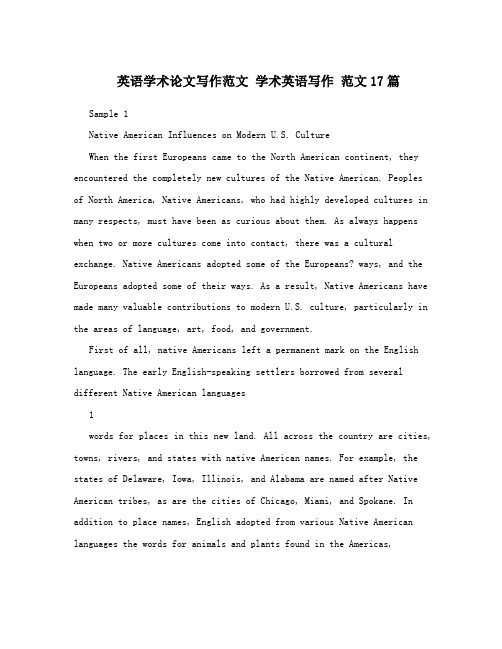
英语学术论文写作范文学术英语写作范文17篇Sample 1Native American Influences on Modern U.S. CultureWhen the first Europeans came to the North American continent, they encountered the completely new cultures of the Native American. Peoples of North America, Native Americans, who had highly developed cultures in many respects, must have been as curious about them. As always happens when two or more cultures come into contact, there was a cultural exchange. Native Americans adopted some of the Europeans? ways, and the Europeans adopted some of their ways. As a result, Native Americans have made many valuable contributions to modern U.S. culture, particularly in the areas of language, art, food, and government.First of all, native Americans left a permanent mark on the English language. The early English-speaking settlers borrowed from several different Native American languages1words for places in this new land. All across the country are cities, towns, rivers, and states with native American names. For example, the states of Delaware, Iowa, Illinois, and Alabama are named after Native American tribes, as are the cities of Chicago, Miami, and Spokane. In addition to place names, English adopted from various Native American languages the words for animals and plants found in the Americas,Chipmunk, moose, raccoon, skunk, tobacco, and squash are just a few examples.Although the vocabulary of English is the area that shows the most Native Americaninfluence, it is not the only area of U.S. culture that has been shaped by contact with NativeAmericans. Art if another area of important Native American contributions. Wool rugs woven by women of the Navajo Tribe in Arizona and New Mexico are highly valued works of art in the United States. Native American jewelry made from silver and turquoise is also very popular and very expensive. Especially in the western and southwestern regions of the United States, native crafts such as pottery, leather products, and beadwork can be found in many homes. Indeed, native art and handicrafts are a treasured2part of U.S. culture.In addition to language and art, agriculture is another area inwhich Native Americans had a great and lasting influence on the peoples who arrived here from Europe, Africa, and Asia. Being skilled farmers, the Native Americans of North America taught the new comers many things about farming techniques and crops. Every U.S. schoolchild has heard the story of how Native Americans taught the first settlers to place a dead fish in a planting hole to provide fertilizer for the growing plant. Furthermore, they taught the settlers irrigation methods and croprotation. Many of the foods people in the United States eat today were introduced to the Europeans by Native Americans. For example, corn and chocolate were unknown in Europe. Now they are staples in the U.S. diet.Finally, it may surprise some people to learn that citizens of the United States are also indebted to the native people for our form of government. The Iroquois, who were an extremely large tribe with many branches called “nations”,had developed a highly sophisticated system of government to settle disputes that arose between the various branches. Five of the nationshad joined together in a confederation3called “The League of the Iroquois.” Under th e league, eachnation was autonomous in running its own internal affairs, but the nations acted as a unit when dealing with outsiders. The league kept the Iroquois from fighting among themselves and was also valuable in diplomatic relations with other tribes. When the 13 colonies were considering what kind of government to establish after they had wontheir independence from Britain,someone suggested that they use a system similar to that of the League of the Iroquois. Under this system, each colony or future state would be autonomous in managing its own affairs but would join forces with the other states to deal with matters that concerned them all. This is exactly what百度搜索“就爱阅读”,专业资料,生活学习,尽在就爱阅读网,您的在线图书馆happened. As a result, the presentfrom of government of the United States can be traced directly back to a Native American model.In conclusion, we can easily see from these few examples the extent of Native American influence on our language, our art forms, out eating habits, and our government. The people of the United States are deeply indebted to Native4Americans for their contributions to U.S. Culture.Exercise: Complete the outline by filling in the missing parts.Native American Influences on Modern U.S. CultureI. IntroductionThesis statement:___________________________________________________________ II. BodyA. Native Americans left a permanent mark on the English language.1. Names of places-cities, towns, rivers, and statesa. States: Delaware, Iowa, Illinois, Alabamab. Cities: Chicago, Miami, Spokane2. Names of animals and plantsa. Animals: chipmunk, moose, raccoon, skunkb. Plants: tobacco, squashB._____________________________________________________________1. Navajo rugs2. Silver and turquoise jewelry3.5______________________________________________________________a. Potteryb._____________________________________________________c._____________________________________________________c.______________________________________________________________1. Farming techniquesa._________________________________________________b. ________________________________________________2._____________________________________________________a._________________________________________________b. ________________________________________________6D. _1. Iroquois-large tribe with many branches (“nations”) Needed to settle disputes among various branches2. Five nations formed League of Iroquoisa._________________________________________________b. Acted together when dealing with outsiders3. After independence, 13 colonies adopted similar system.a. Each colony (future state) was autonomous in managing own affairs.b.______________________________________________________III. Conclusion___________________________________________________________百度搜索“就爱阅读”,专业资料,生活学习,尽在就爱阅读网,您的在线图书馆Sample 2:At the MoviesYou Are Where You Sit: Seating Choice Can Tell a Lot about a Person!71 When he goes to the movies, Ravel Centeno likes to sit on theaisle and stretch his feet out-a fact that by itself speaks volumesabout his personality, according to a new study. The study, commissioned by the British movie theater company Odeon, examined how theater seating habits reflect personality. And as the summer movie season reaches its zenith, the research says you are where you sit. Psychologist Donna Dawson divided moviegoers into four different personality types based on their seating preferences and cited examples of movie characters who fit those types.2 Those who sit on the aisle, like Centeno, are “detached observers”-people who like to have their own space, who are observers and tend to be quieter. “That?s funny, because I?m a writer,” Centeno said Thursday as he waited to see AI. atthe CineplexOdeon at Universal CityWalk. “So that?s what I do (observe people).” One celluloid example of a detached observer, said Dawson, is Jack Nicholson?s Melvin Udall character in As Good as It Gets.3 Other personality types, according to Dawson:4 The “front row film fanatic”: Extroverted, assertive, and8competitive, these are people who like to see movies with others,not on their own. An example from the movies might be Mike Meyers?s Austin Powers or Julia Roberts?s ErinBrockovich.5 The”middle-of-the-roaders”: These are the people wholike to sit in the middle, fittingly. They are people who areflexible and try to get along with others, such as Gwyneth Paltrow?s Emma. Gloria and Tom Candelaria of Redlands say that seems to fit them. “We like the middle because it?s not too far back and not too close to the front,” Gloria Candelaria said as she scanned the marquee at CityWalk. Tom Candelaria said the “middle-of-the-roader” label seems to fit them because “we?re easygoing.”6 The “invisible rebels”: Those who sit far in the back are people who are rebellious and like excitement but don?t necessary seek the limelight, the study said. A typical example is ClintEastwood?s Man with No Name and Sigourney Weaver?s Lt. Ripley in the Alien films. “The back row is,where things happen; it?s an exciting area of danger and lots of passionate smooching,” Dawson said in the Odeon report. “It tends to attract people who are rebellious.”97 For some people, though, sometimes a chair i s just a chair. “I don?t knowwherever there?s an empty seat,” said filmgoer Chris Marshall of Lake Hollywood, when asked where he likes to sit. “That works for me.”Questions About the Organization1. What kind of introduction does this newspaper article have?a. It is a funnel introduction-it begins with a general statement and narrows down to the thesis statement.b. It begins with an example and ends with the thesis statement.c. It explains the reasons for the study and ends with the thesis statement.2. What kind of conclusion does it have?a. It summarizes the four main personality types.b. It gives the writer?s opinion on the study.c. It gives an example that contrasts with the main points.3. What words in the thesis statement indicate that the article uses logical division of ideas as a百度搜索“就爱阅读”,专业资料,生活学习,尽在就爱阅读网10,您的在线图书馆pattern of organization?About the Support4. What two kinds of supporting details are used in this article?_________ and _________5. The psychologist who made the study used one kind of support, and the writer of the article reporting the results of the study used another kind. Which person used which kind?a. The psychologist used _b. The writer used _About the Content6. How do we know if the psychologist is correct? Does the article mention the methods she used in her study to match seating preference and personality type, or does it report only the results?百度搜索“就爱阅读”,专业资料,生活学习,尽在就爱阅读网,您的在线图书馆Sample 3Culture ShockMoving to a new country can be an exciting, even exhilarating experience. In a newenvironment, you somehow feel more alive: seeing new11sights, eating new food, hearing theforeign sounds of a new language, and feeling a different climate against your skin stimulate your senses as never before. Soon, however, this sensory bombardment becomes sensory overload. Suddenly, new experiences seem stressful rather than stimulating, and delight turns intodiscomfort. This is the phenomenon known as culture shock. Culture shock is more than jet lag or homesickness, and it affects nearly everyone who enters a newculture-tourists, business travelers, diplomats, and students alike. Although not everyone experiences culture shock in exactly the same way, many experts agree that it has roughly five stages.In the first stage, you are excited by your new environment. You experience some simple difficulties such as trying to use the telephone or public transportation, but you consider these small challenges that you can quickly overcome. Your feelings about the new culture are positive, so you are eager to make contact with people and to try new foods.Sooner or later, differences in behavior and customs become more noticeable to you. This is the second stage of culture shock. Because you do not know the social customs12of the new culture, you may find it difficult to make friends. For instance, you do not understand how to make “small talk,” so it ishard to carry on a casual, get-acquaintedconversation. One day in the schoolcafeteria, you overhear a conversation. You understand all the words, but you do not understand the meaning. Why is everyone laughing? Arethey laughing at you or at some joke that you did not understand? Also, you aren?t always sure how to act while shopping. Is this store self-service, or should you wait for a clerk to assist you? If you buy a sweater in the wrong size, can you exchange it? These are not minor challenges; they are major frustrations.In the third stage, you no longer have positive feelings about the new culture. You feel that you have made a mistake in coming here. Making friends hasn?t been easy, so you begin to feel lonely and isolated. Now you want to be with familiar people and eat familiar food. You begin to spend most of your free time with students from your home country, and you eat in restaurants that serve your native food. In fact, food becomes an obsession, and you spend a lot of time planning, shopping for, and cooking food from home.You know that you are in the fourth stage of culture shock13when you have negative feelings about almost everything. In this stage, you actively reject the new culture. You become critical, suspicious, and irritable. You believe that people are unfriendly, thatyour landlord is trying to cheat you, that your teachers do not like you, and that the food is making you sick. In fact, you may actually develop stomachaches, headaches, sleeplessness, lethargy, or other physical symptoms.Finally, you reach the fifth stage. As your language skills improve, you begin to have somesuccess in meeting people and in negotiating situations. You areable to exchange the sweater that was too small, and you cansuccessfully chat about the weather with a stranger on the bus. Yourself-confidence grows. After realizing that you cannot change your surroundings, you begin to accept the differences and tolerate them. For instance, the food will never be as tasty as the food in your home country, but you are now able to eat and sometimes even enjoy many dishes. You may not like the way some people in your host country dress or behave in public, but you do not regard their clothes and behavior as wrong-just different.14Concluding Paragraph A百度搜索“就爱阅读”,专业资料,生活学习,尽在就爱阅读网,您的在线图书馆To sum up, culture shock is a veryreal phenomenon that has been studied for more than 30 years by psychologists and anthropologist$. Its five phases are (1) positive feelings toward the new culture, (2) awareness of small differences, (3) growing discomfort and need for contact with home culture, (4) negativefeelings, and (5) acceptance and adjustment. Symptoms may vary, and not all people experience all five phases. In the end, however, people who suffer culture shock are stronger from having overcome the difficulties and frustrations of adapting to life in a new land. Concluding Paragraph BIn conclusion, nearly everyone moving to a new country feels some degree of culture shock. Symptoms may vary, and not all people experience all five stages. Newcomers with a strong support group may feel at home immediately in the new culture, while others may take months to feel comfortable. Staying in touch with friends and family, keeping a positive attitude, and, above all, learning the language as soon as possible are ways to overcome the15difficulties and frustrations of adapting to life in a new land.Exercise:1. Which concluding paragraph best suits the passage and why?2. Which concluding paragraph is a summary of the subtopics? Which one paraphrases the thesisstatement?3. Which concluding paragraph gives suggestions? Which one makes a prediction?百度搜索“就爱阅读”,专业资料,生活学习,尽在就爱阅读网,您的在线图书馆Sample 4: Cause and Effect百度搜索“就爱阅读”,专业资料,生活学习,尽在就爱阅读网,您的在线图书馆百度搜索“就爱阅读”,专业资料,生活学习,尽在就爱阅读网,您的在线图书馆Sample 5: Cause and Effect16百度搜索“就爱阅读”,专业资料,生活学习,尽在就爱阅读网,您的在线图书馆Sample 6: Comparison百度搜索“就爱阅读”,专业资料,生活学习,尽在就爱阅读网,您的在线图书馆百度搜索“就爱阅读”,专业资料,生活学习,尽在就爱阅读网,您的在线图书馆Sample 7: ComparisonCLASSROOM LEARNING AND INTERNETBASEDTEACHINGSince the late 1990s internet-based teaching (also known as e-education) has emerged as a potential rival to traditional classroom learning. It normally involves having access to a secure site on the internet where a graded series of lessons are available, and which have assignments sent and returned by email. Although on-line courses are now offered by many institutions, it is by no means clear that they offer real advantages compared to classroom education. Little research has been done so far on their effectiveness, but this17essay sets out to examine the arguments on both sides and attemptsto draw conclusions from them.Two main advantages of internet use in education are put forward. Firstly, it is seen as more economical, in that once a course is prepared, it can be used by large numbers of students. The savings made by not having to employ so many teachers should be reflected in cheaper course fees. The second benefit is convenience; instead of having to attend classes at fixed times and places, students are free to study when they choose and progress at their own pace. Furthermore, by studying from home there is no need to travel to the college or university, saving both time and money. A student living in a small town in China, for example, can now study a course at an American college without the worry of travelling, accommodation or homesickness.Despite the considerations mentioned above, classroom learning shows no signs of being replaced by e-learning. It seems that face-to-face contact with a teacher is still widely regarded as the best way for students to make progress, despite the expense and inconvenience involved. Not only the personal contact with a teacher, but also the support and18encouragement gained from being part of a class may be one reasonfor this. Membership of a group may also create a useful spirit of competition, which stimulates learning.Given the increasing pressure on university places in many countries, internet-based teaching is often seen as a convenient development. However, e-learning eliminates personal contact and travel from education, which are possibly the aspects many students value. Sittingat home working on a computer may be economical, but clearly cannot replace the social experience of attending courses. However, there are many people who are unable, either through work or family commitments,or due to lack of funds, to go to classes, and who would clearly find internet learning beneficial. On-line courses can also be used tosupport taught courses, for instance by providing access to extra materials. In many ways these kinds of courses are similarto ,universities of the air?, such as Britain?s OpenUniversity, which have developed distance learning so successfullyin the last 40 years.Faced by growing demand for university places, more institutions are likely to develop on-line courses, but the apparent benefits of e-learning may be less than are19generally believed. Students seem to value the personal contact ofthe classroom highly, despite its cost andinconvenience. There may be a role for internet-based courses to supplement teacher-taught ones, and certainly for people with other commitments they will be the only practical option. There is an urgentneed for research on the effectiveness of this type of learning, which should help maximise its advantages in the future.(Approximately 550 words)百度搜索“就爱阅读”,专业资料,生活学习,尽在就爱阅读网,您的在线图书馆Sample 8: Argument百度搜索“就爱阅读”,专业资料,生活学习,尽在就爱阅读网,您的在线图书馆Now complete the outline of the model essay:Separating the Sexes, Just for the Tough YearsI. Introduction (explanation of the issue)Thesis statement:20_______________________________________II. BodyA. Opposing argument 1Opponents of single-sex education claim that test scores show that there is no advantage to all-girl or all-boy classes.Rebuttal to argument 11. Research is inconclusive-show opposite results2. Other results that cannot be calculateda. Girls____________________________________________________________________ _____________________________________________________________________ ____b. Boys____________________________________________________________________ ____________________________________________________________________ ______B. Opposing argument2____________________________________________________________21Rebuttal to argument 2_________________________________________________________a. Settling squabbles with siblingsb. Negotiating with opposite-sex parent百度搜索“就爱阅读”,专业资料,生活学习,尽在就爱阅读网,您的在线图书馆C. Opposing argument 3_________________________________________________________Rebuttal to argument 3___________________________________________________________a._______________________________________________________b. Teachers call on boys more oftenIII.Conclusion1. Same-sex classes provide a better learning environmentReasonsa. Boys and girls___________________________________________________22_____________________________________________________________________________ ______ b.Girl________________________________________________________________ _____ c. Boys____________________________________________________________________2.____________________________________________________________________ __3.____________________________________________________________________ _____百度搜索“就爱阅读”,专业资料,生活学习,尽在就爱阅读网,您的在线图书馆Sample 9A major change that has occurred in the Western family is an increased incidence in divorce. Whereas in the past, divorce was a relatively rare occurrence, in recent times it has become quite commonplace. This change is borne out clearly in census figures. For example thirty years ago in Australia, only one marriage in ten ended in divorce;23nowadays the figure is more than one in three (Australian Bureau of Statistics, 1996: p.45). A consequence of this change has been a substantial increase in the number of single parent families and the attendant problems that this brings (Kilmartin, 1997).An important issue for sociologists, and indeed for all of society,is why these changes in marital patterns have occurred. In this essay I will seek to critically examine a number of sociological explanationsfor the …divorce phenomenon? and also consider the social policy implications that each explanation carries with it. It will be arguedthat the best explanations are to be found within a broad socio-economic framework.One type of explanation for rising divorce has focused on changes in laws relating to marriage. For example, Bilton, Bonnett and Jones (1987) argue that increased rates of divorce do notnecessarily indicate that families are now more unstable. It is possible, they claim, that there has always been a degree of marital instability. They suggest that changes in the law have been significant, because they have provided unhappily married24couples with …access to a legal solution to pre-existentmarital problems? (p.301). Bilton et al. therefore believe that changes in divorce rates can be best explained in terms of changes inthe legal system. The problem with this type of explanation however, is that it does not consider why these laws have changed in the first place.It could be argued that reforms to family law, as well as the increased rate of divorce that has accompanied them, are the product of more fundamental changes in society.Another type of explanation is one that focuses precisely on these broad societal changes. For example, Nicky Hart (cited in Haralambos, 1995) argues that increases in divorce and marital breakdown are the result of economic changes that have affected the family. One example of these changes is the raised material aspirations of families, which Hart suggests has put pressure on both spouses to become wage earners. Women as a result have been forced to become both homemakers and economic providers. According to Hart, the contradiction of these two roles has lead to conflict and this is the main cause of marital breakdown. It would appear that Hart?s explanation cannot account for all cases of divorce - for example, marital breakdown is liable to occur25in families where only the husband is working. Nevertheless, her approach, which is to relate changes in family relations to broader social forces, would seem to be more probing than one that looks only at legislative change.The two explanations described above have very differentimplications for social policy,especially in relation to how the problem of increasing marital instability might be dealt with. Bilton et al. (1995) offer a legal explanation and hence would see the solutions also beingdetermined in this domain. If rises in divorce are thought to be the consequence of liberal divorce laws, the obvious way to stem this riseis to make them less obtainable. This approach, oneimagines, would lead to a reduction in divorce statistics; however, it cannot really be held up as a genuine solution to the problems of marital stress and breakdown in society. Indeed it would seem to be a solution directed more at symptoms than addressing fundamental causes.Furthermore, the百度搜索”就爱阅读”,专业资料,生活学习,尽在就爱阅读网26,您的在线图书馆experience of social workers,working in the area of family welfare suggests that restricting a couple?s access to divorce would in some cases serve only to exacerbate existing marital problems (Johnson, 1981). In those cases where violence is involved, the consequences could be tragic. Apart from all this, returning to more restrictive divorce laws seems to be a solution little favoured by Australians. (Harrison, 1990).Hart (cited in Haralambos, 1995), writing from a Marxist-feminist position, traces marital conflict to changes in the capitalist economic system and their resultant effect on the roles of men and women. It is difficult to know however, how such an analysis might be translated into practical social policies. This is because the Hart program would appear to require in the first place a radical restructuring of the economic system. Whilst this may be desirable for some, it is not achievable inthe present political climate. Hart is right however, to suggest that much marital conflict can be linked in some way to the economic circumstances of families. This is borne out in many statistical surveys which show consistently that rates of divorce are higher among socially disadvantaged families27(McDonald, 1993). This situation suggests then that social policies need to be geared to providing support and security for these types of families. It is little cause foroptimism however, that in recent years governments of all persuasions have shown an increasing reluctance to fund social welfare programs of this kind.It is difficult to offer a comprehensive explanation for the growing trend of marital breakdown; and it is even more difficult to find solutions that might ameliorate the problems created by it. Clearly though, as I have argued in this essay, the most useful answers are to be found not within a narrow legal framework, but within a broadersocio-economic one.Finally, it is worth pointing out that, whilst we may appear to be living in a time of increased family instability, research suggests that historically, instability may have been the norm rather than the exception. As Bell and Zajdow (1997) point out, in the past, single parent and step families were more common than is assumed - although the disruptive influence then was not divorce, but the premature death of。
英语学术论文范文范文怎么写
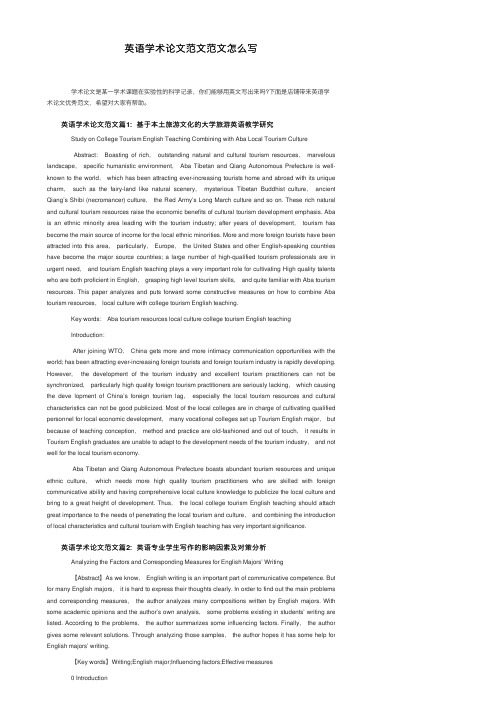
英语学术论⽂范⽂范⽂怎么写 学术论⽂是某⼀学术课题在实验性的科学记录,你们能够⽤英⽂写出来吗?下⾯是店铺带来英语学术论⽂优秀范⽂,希望对⼤家有帮助。
英语学术论⽂范⽂篇1:基于本⼟旅游⽂化的⼤学旅游英语教学研究 Study on College Tourism English Teaching Combining with Aba Local Tourism Culture Abstract:Boasting of rich,outstanding natural and cultural tourism resources,marvelous landscape,specific humanistic environment,Aba Tibetan and Qiang Autonomous Prefecture is well-known to the world, which has been attracting ever-increasing tourists home and abroad with its unique charm,such as the fairy-land like natural scenery,mysterious Tibetan Buddhist culture,ancient Qiang’s Shibi (necromancer) culture, the Red Army’s Long March culture and so on. These rich natural and cultural tourism resources raise the economic benefits of cultural tourism development emphasis. Aba is an ethnic minority area leading with the tourism industry; after years of development,tourism has become the main source of income for the local ethnic minorities. More and more foreign tourists have been attracted into this area, particularly, Europe, the United States and other English-speaking countries have become the major source countries; a large number of high-qualified tourism professionals are in urgent need, and tourism English teaching plays a very important role for cultivating High quality talents who are both proficient in English, grasping high level tourism skills, and quite familiar with Aba tourism resources. This paper analyzes and puts forward some constructive measures on how to combine Aba tourism resources, local culture with college tourism English teaching. Key words: Aba tourism resources local culture college tourism English teaching Introduction: After joining WTO, China gets more and more intimacy communication opportunities with the world; has been attracting ever-increasing foreign tourists and foreign tourism industry is rapidly developing. However,the development of the tourism industry and excellent tourism practitioners can not be synchronized, particularly high quality foreign tourism practitioners are seriously lacking, which causing the deve lopment of China’s foreign tourism lag,especially the local tourism resources and cultural characteristics can not be good publicized. Most of the local colleges are in charge of cultivating qualified personnel for local economic development, many vocational colleges set up Tourism English major, but because of teaching conception, method and practice are old-fashioned and out of touch, it results in Tourism English graduates are unable to adapt to the development needs of the tourism industry, and not well for the local tourism economy. Aba Tibetan and Qiang Autonomous Prefecture boasts abundant tourism resources and unique ethnic culture,which needs more high quality tourism practitioners who are skilled with foreign communicative ability and having comprehensive local culture knowledge to publicize the local culture and bring to a great height of development. Thus, the local college tourism English teaching should attach great importance to the needs of penetrating the local tourism and culture, and combining the introduction of local characteristics and cultural tourism with English teaching has very important significance. 英语学术论⽂范⽂篇2:英语专业学⽣写作的影响因素及对策分析 Analyzing the Factors and Corresponding Measures for English Majors’ Writing 【Abstract】As we know, English writing is an important part of communicative competence. But for many English majors, it is hard to express their thoughts clearly. In order to find out the main problems and corresponding measures,the author analyzes many compositions written by English majors. With some academic opinions and the author’s own analysis, some problems existing in students’ writing are listed. According to the problems, the author summarizes some influencing factors. Finally, the author gives some relevant solutions. Through analyzing those samples, the author hopes it has some help for English majors’ writing. 【Key words】Writing;English major;Influencing factors;Effective measures 0 Introduction “English writing is a re-creation process where students use the knowledge of the language through thinking. So writing skills can reflect students’ language competence” (Bai 2009:99). But for many English majors,English writing is a difficulty for them. So many reasons have led to this kind of phenomenon. The author summarizes several types of mistakes that English majors often make, such as vocabulary mistakes,grammar mistakes. According to these problems,the author analyzes the influencing factors and tries to find suitable ways to solve this problem. 1 Influencing Factors 1.1 Vocabulary Mistakes Generally there are three kinds of vocabulary mistakes existing in English majors’ writing. They are spelling mistake,collocation mistake and part of speech problem. In the following part,they are discussed one by one. First,the spelling mistakes are common in their compositions. “Vocabulary is the requisite element of English writing” (He 2008:141). If students want to write a good composition to express their thoughts, they should grasp enough vocabulary and understand words correctly. However, most English majors do not learn vocabulary like that. For example, the words “indepadent” is not correct in spelling; the words “indepondance” and “independent” are not correct; the words “dapt”,“nowdays” are not spelled correctly. This is because students neglect the spelling when they learn the word at the beginning. What’s more, many students recite the word in accordance with pronunciation. Second,collocation mistakes occur frequently. Collocation is the key point of vocabulary learning. It plays a vital role in expressing the author’s intention. As we all know, the English collocation is very different from Chinese. Some students are used to thinking in Chinese and then directly translate Chinese into English literally. Such literal translations will definitely lead to mistakes. Generally speaking,the words do not appear isolated from others. That is to say, there are fixed about collocation between adjective and noun,verb and object noun etc. However,students often do not pay attention to this collocation and accumulate the words mechanically, leading to inappropriate expression in English. For example, “look dinner” and “leave earth” are not appropriate. 英语学术论⽂范⽂篇3:马丁. 路德.⾦《我有⼀个梦》的⽂体分析 Abstract: On the base of the definition of stylistics, this thesis gives a detailed analysis of some the of stylistic devices used in the famous speech by the well-known American civil rights movement leader Martin Luther King, Jr., and then probes into the stylistic characteristics of speech as a style. Key words: Stylistics, Stylistic devices, analysis, speech. 马丁. 路德.⾦《我有⼀个梦》的⽂体分析 摘要:本⽂⾸先阐述了⽂体学的定义,并在此基础上对对美国着名⿊⼈领袖马丁. 路德.⾦的着名演讲《我有⼀个梦》中所使⽤的⽂体⼿段进⾏了详尽的分析,进⽽对演讲⽂体的风格进⾏了简要的论述。
英语学术论文范文【可编辑版】

英语学术论文范文英语学术论文范文英语学术论文范文:1. TitleStrategies of Oral English Teahing in Senior ShoolsThesis StatementThe urrent soial bakgrounds hih make Oral English bee an important part in the English learning proess are urgent. Teahers in senior shools alas enounter man problems in their Oral English teahing. This stud disusses the major auses, and gives some reative solutions to them.3. Purposes and Signifiane of StudIn reent ears it has been argued on both linguisti and pshologial grounds that Oral English should be the prinipal objetive in English teahing. Most textbooks plae emphasis more on Oral English in that the embod a methodolog that is largel oral. The urrent problems that appear in Oral English teahing in senior shools are the greatest obstales hih prevent students from learning English ell. With the globalization of soial life and eonom, the proess of opening up to the outside bees quikl, to a ertain extent, the requirements for the ultivation of Oral English are instant.This stud ill help senior teahers and learners analze the potential problems and speifi methods to deal ith.4. Situation of StudCorder vies his opinions that the seond language aquisition provides to the researher evidene of ho languageis learned or aquired, hat strategies or proedures the learners are emploing in his disover of the language.Segaloitz and Gatbouton take their vie as that language learning partiularl the oral petene has begun to fous on the teahing strategies.Goffman points out that oral talking is often organized into to-part exhanges, this organizing prinipal follos from the ver fundamental requirements of oral speeh as a muniation sstem. The Teahing Sllabus stipulates that Band One requires senior shool students to retell main ideas based on the general meaning of the passages, and an do some introdution about famil, friends, or lass b using simple sentenes and expressions. Band To desribes that students an anser questions and disuss aording to the text effiientl. It also requires students to do dail talk about soiet, ulture and siene hih related to the text in the textbooks.The High Shool English Standards stipulates that Band Six requires senior shool students to do dail onversations and express on opinions on the given topis. Students an desribepersonal experienes and express oneself appropriatel on some speifi oasions. Band Eight stresses that students an make a3-minute speeh based on simple topis b preparation in a short time, and do some simple translations in dail life.Theories about ho e teah oral English reflet our vie of the nature of language. A deeper understanding of the effets of muniative needs on non-native speaker disourse should make us more understanding of our students diffiulties inpratising their Oral English. It is generall aepted that English plas an important part in the basi eduation ourses, and even in the advaned eduation. In the past, English teahing laid great emphasis on the grammatial strutures instead of Oral English teahing. This leads to some serious problems that most learners in China have studied English for more ten ears, et the annot muniate ith native English speakers naturall. The probabl lak the language environment, and most of them have no opportunities to pratie their English orall in lass. Furthermore, teahers, some of hom annot have ver good oral English, in some bakard and remote areas of China, are not qualified. These ertainl leave students the diret impat on the motivation of English learning.5. Diffiult of StudIt is a little bit hard for senior students to spend some time everda to pratie their Oral English beause of the heav pressure of the entrane examination to ollege. Meanhile, in vie of the test-oriented sstem in China, teahers often emphasize a lot on preparing lesson plans for their students. Moreover, the solutions that offered in this stud annot be put into pratie easil. Colleting the materials andinformation is another diffiult thing for m limited time energ.6. Outline1. IntrodutionTheoretial Frameork1 Foreign Language Methodologies2 The Requirements of the High Shool English Standards3 Theories of the seond language aquisition4 Motivations for Senior Students English Learning3. The Causes of the Problems3.1 Students Fators in Their Oral English Learning3.1.1 Lak of Language Environment3.1.2 Fe Opportunities to Contat ith English3.1.3 Lak of Confidene and Creativit1.4 The Impat of Pshologial Obstales3.2 Teahers Fators in Their Oral English Teahing 3.1 Less profiien in teahers oral English3.2 Poor Teahing Theories and Strategies3.3 The Traditional Teahing Modes3.3 Administrators Problems3.3.1 Large Class3.3.2 The Current English Test Sstem4. Solutions4.1 The solutions to Students Problems4.1.1 Cultivation of Language Environment4.1.2 Creation of More Chanes to Pratie Oral English 4.1.1 Reitation Method4.2 Step-b-step Method4.1.3 Finding the fixed partners to pratie4.1.3 Fostering Self-onfidene and Creativit4.2 The Solutions to Teahers Problems4.1 Professionalism for Teahers Oral English4.2 Attempt of Ne Teahing Theories and Strategies 4.1 Model-based Method4.2 Theme-based Method4.3 Question Anser Method4.4 Interative Approah4.5 Group Ativities4.6 Role pla7 Disussion and Debate4.8 The Art of Correting Mistakes4.3 The Solutions to Governments Eduation Poli4.3.1 Small Class4.3.2 The Reform of English Test Sstem5. ConlusionBibliograph Rihards, J. J. The Context of Language Teahing. Beijing:Foreign Language and Researh Press, 201X Robins, R. H. General Linguistis. Beijing:Foreign Language and Researh Press, 201X 成云.心理学. 成都:四川大学出版社, 201X 胡春洞.英语教学法. 北京:高等教育出版社,90 刘家坊. 教育学. 成都:四川大学出版社,201X中国教育部. 全日制普通高级中学英语教学大纲. 北京:人民教育出版社, 201X 钟启泉. 外语教育展望. 上海:华东师范大学出版社, 2001以上这篇英语学术论文范文为您介绍到这里,希望它对您有帮助。
英文学术论文写作

英文学术论文写作学术论文写作用英语写学术论文的目的主要有两个,一是参加国际学术会议,在会议上宣讲,促进学术交流;二是在国际学术刊物上发表,使国外同行了解自己的研究成果,同样也是出于学术交流的目的。
不同的学科或领域、不同的刊物对论文的格式有不同的要求,但各个领域的研究论文在文体和语言特点上都有许多共性。
了解了这些语言共性,便会起到触类旁通的作用。
对我国青年学者或学生来说,用英语写作的难点不是没有写作材料,不是不熟悉专业词汇,也不是没有打下良好的英语基础。
用英语写论文难,是因为不太了解学术英语的语言特点。
关于学术英语写作的语言技巧,我们已在第一部分作了较详细的介绍。
此部分讨论学术论文写作的方法,包括学术论文写作中常用的句型结构,我们都在此作较详细介绍,以便读者模仿练习,将写作工作化难为易。
一般来说,一篇完整规范的学术论文由以下各部分构成:Title(标题)Abstract(摘要)Keywords(关键词)Table of contents(目录)Nomenclature(术语表)Introduction(引言)Method(方法)Results(结果)Discussion(讨论)Conclusion(结论)Acknowledgement(致谢)Reference(参考文献)Appendix(附录)其中Title,Abstract,Introduction,Method,Result,Discussion,Conclusion,Reference等八项内容是必不可少的(其他内容根据具体需要而定)。
在这八项内容中,读者最多的是Title,Abstract和Introduction部分,读者会根据这些内容来决定是否阅读全文。
也就是说,一篇研究论文赢得读者的多少,在很大程度上取决于Title,Abstract和Introduction写得好坏。
因此这三项内容将各分章详细加以讲述。
学术论文的正文一般包括Method,Result,Discussion三个部分。
学术英语论文范文精选3篇(全文)
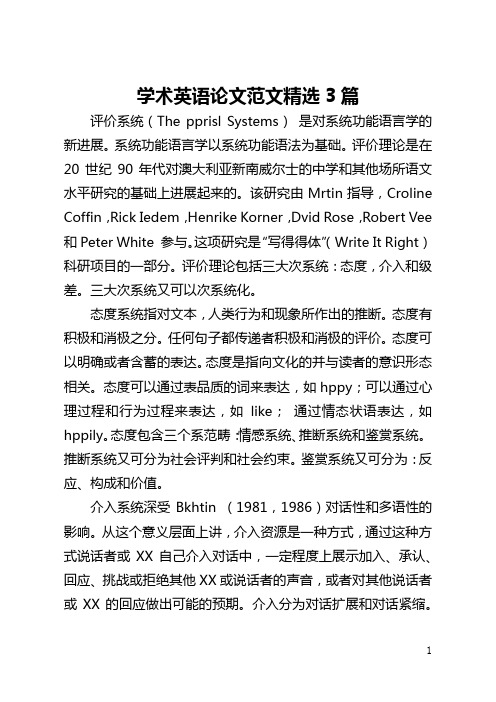
学术英语论文范文精选3篇评价系统(The pprisl Systems)是对系统功能语言学的新进展。
系统功能语言学以系统功能语法为基础。
评价理论是在20世纪90年代对澳大利亚新南威尔士的中学和其他场所语文水平研究的基础上进展起来的。
该研究由Mrtin指导,Croline Coffin,Rick Iedem,Henrike Korner,Dvid Rose,Robert Vee 和Peter White 参与。
这项研究是“写得得体”(Write It Right)科研项目的一部分。
评价理论包括三大次系统:态度,介入和级差。
三大次系统又可以次系统化。
态度系统指对文本,人类行为和现象所作出的推断。
态度有积极和消极之分。
任何句子都传递者积极和消极的评价。
态度可以明确或者含蓄的表达。
态度是指向文化的并与读者的意识形态相关。
态度可以通过表品质的词来表达,如hppy;可以通过心理过程和行为过程来表达,如like;通过情态状语表达,如hppily。
态度包含三个系范畴:情感系统、推断系统和鉴赏系统。
推断系统又可分为社会评判和社会约束。
鉴赏系统又可分为:反应、构成和价值。
介入系统深受Bkhtin (1981,1986)对话性和多语性的影响。
从这个意义层面上讲,介入资源是一种方式,通过这种方式说话者或XX自己介入对话中,一定程度上展示加入、承认、回应、挑战或拒绝其他XX或说话者的声音,或者对其他说话者或XX的回应做出可能的预期。
介入分为对话扩展和对话紧缩。
对话扩展又可次系统化为包容和归属;对话紧缩可次系统化为弃言和借言。
介入可以通过情态词、言剧性表达、模糊语等来实现,如my,it is sid tht等。
级差系统是对态度介入的程度的分级资源,包含语势和聚焦。
语势有强势和弱势之分,聚焦有明显和模糊之分。
级差可以通过一些表程度的词来实现,如some,plusible等。
3.语料本项研究的语料是60篇英文4.研究结果及分析本研究分别从三个次系统对语料进行分析:态度,介入,级差。
英语学术议论文作文模板

英语学术议论文作文模板Title: Academic Paper Writing Template。
Abstract:This paper provides a template for writing an academic paper in English. It outlines the structure, formatting, and style guidelines that are commonly used in academic writing. The template is designed to help writers organize their thoughts and present their ideas in a clear, logical, and scholarly manner.Introduction:Academic writing is a critical skill for students, researchers, and professionals in various fields. Whether it is a research paper, a literature review, a thesis, or a dissertation, the ability to communicate complex ideas in a clear and coherent manner is essential. This template aims to provide a framework for organizing and presenting academic papers effectively.1. Title Page:The title page should include the title of the paper, the author's name, the institutional affiliation, and the date of submission. The title should be concise and informative, accurately reflecting the content of the paper. The author's name should be followed by the institutional affiliation, and the date of submission should be placed at the bottom of the page.2. Abstract:The abstract is a brief summary of the paper, providing an overview of the research question, methodology, findings, and conclusions. It should be concise, informative, and well-written, allowing readers to quickly grasp the main points of the paper. The abstract is typically 150-250 words in length and is placed at the beginning of the paper.3. Introduction:The introduction provides background information on the topic, outlines the research question or problem, and presents the purpose and significance of the study. It should also include a brief overview of the paper's structure and organization. The introduction should be engaging and informative, setting the stage for the rest of the paper.4. Literature Review:The literature review provides a critical analysis of existing research and scholarship on the topic. It should identify gaps, contradictions, and debates in the literature, and provide a rationale for the current study. The literature review should be well-organized, focused, and comprehensive, demonstrating the writer's understanding of the relevant literature.5. Methodology:The methodology section describes the research design, data collection methods, and data analysis procedures. It should provide a clear and detailed explanation of how the study was conducted, allowing readers to evaluate the validity and reliability of the findings. The methodology should be precise, transparent, and replicable.6. Results:The results section presents the findings of the study in a clear and organized manner. It should include tables, figures, and statistical analyses as necessary, and provide a narrative description of the key findings. The results should be presented objectively, without interpretation or speculation.7. Discussion:The discussion section interprets the findings in relation to the research question, the literature, and the theoretical framework. It should highlight the significance of the findings, address any limitations or weaknesses of the study, and suggest implications for future research or practice. The discussion should be analytical, reflective, and well-supported by evidence.8. Conclusion:The conclusion summarizes the main findings and arguments of the paper, reiterates the significance of the study, and offers final thoughts or recommendations. It should be concise, focused, and persuasive, leaving readers with a clear understanding of the paper's contributions and implications.9. References:The references section lists all the sources cited in the paper, following a specific citation style (e.g., APA, MLA, Chicago). It should be accurate, consistent, and complete, allowing readers to locate and verify the sources used in the paper.10. Formatting and Style Guidelines:The paper should be formatted according to the requirements of the target journal or academic institution. This includes margins, font size and style, line spacing, headings, and pagination. The writing style should be formal, objective, and precise, using clear and concise language.Conclusion:This template provides a comprehensive framework for writing an academic paper in English. By following the guidelines outlined in this template, writers can effectively organize their ideas, present their arguments, and communicate their findings in a scholarly manner. Academic writing is a skill that can be developed and improved with practice, and this template serves as a valuable tool for writers at all levels of proficiency.。
英语学术论文写作(第三版)--第2章--Research Proposal

shortcut
home Main Exercise
Chapter Two Part One: Research Proposal Writing
shortcut
home Main Exercise
1. Definition of Research Proposal
Research proposal is a brief (up to two pages or more) overview of your research paper, giving the reader sufficient information about the work you have done, about the way you did it and the value of this work.
shortcut
home Main Exercise
3. Common Mistakes in Proposal Writing
The following are the common mistakes in proposal writing.
●Failure to provide the proper context to frame the research question. ● Failure to delimit the boundary conditions for your research. ● Failure to cite landmark studies. ● Failure to accurately present the theoretical and empirical contributions by other researchers. ● Failure to stay focused on the research question.
英语学术论文写作
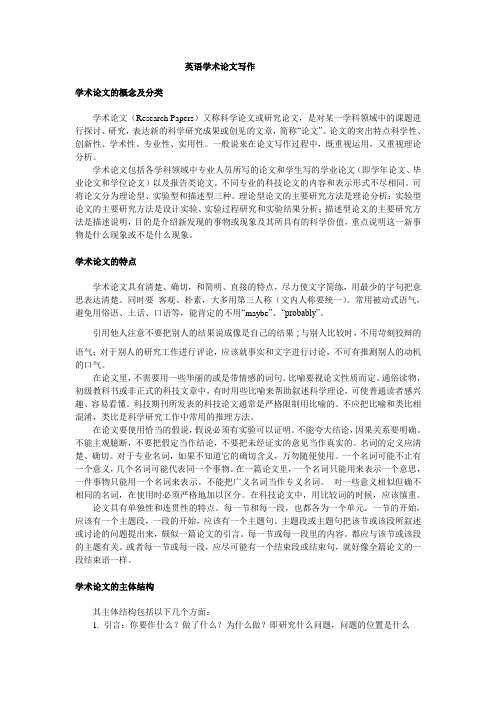
英语学术论文写作学术论文的概念及分类学术论文(Research Papers)又称科学论文或研究论文,是对某一学科领域中的课题进行探讨、研究,表达新的科学研究成果或创见的文章,简称“论文”。
论文的突出特点科学性、创新性、学术性、专业性、实用性。
一般说来在论文写作过程中,既重视运用,又重视理论分析。
学术论文包括各学科领域中专业人员所写的论文和学生写的学业论文(即学年论文、毕业论文和学位论文)以及报告类论文。
不同专业的科技论文的内容和表示形式不尽相同。
可将论文分为理论型、实验型和描述型三种。
理论型论文的主要研究方法是理论分析;实验型论文的主要研究方法是设计实验、实验过程研究和实验结果分析;描述型论文的主要研究方法是描述说明,目的是介绍新发现的事物或现象及其所具有的科学价值,重点说明这一新事物是什么现象或不是什么现象。
学术论文的特点学术论文具有清楚、确切,和简明、直接的特点,尽力使文字简练,用最少的字句把意思表达清楚。
同时要客观、朴素,大多用第三人称(文内人称要统一)。
常用被动式语气,避免用俗语、土话、口语等,能肯定的不用“maybe”、“probably”。
引用他人注意不要把别人的结果说成像是自己的结果;与别人比较时,不用苛刻狡辩的语气;对于别人的研究工作进行评论,应该就事实和文字进行讨论,不可有推测别人的动机的口气。
在论文里,不需要用一些华丽的或是带情感的词句。
比喻要视论文性质而定。
通俗读物,初级教科书或非正式的科技文章中,有时用些比喻来帮助叙述科学理论,可使普通读者感兴趣、容易看懂。
科技期刊所发表的科技论文通常是严格限制用比喻的。
不应把比喻和类比相混淆,类比是科学研究工作中常用的推理方法。
在论文要使用恰当的假说,假说必须有实验可以证明。
不能夸大结论,因果关系要明确。
不能主观臆断,不要把假定当作结论,不要把未经证实的意见当作真实的。
名词的定义应清楚、确切。
对于专业名词,如果不知道它的确切含义,万勿随便使用。
学术专著英语作文模板
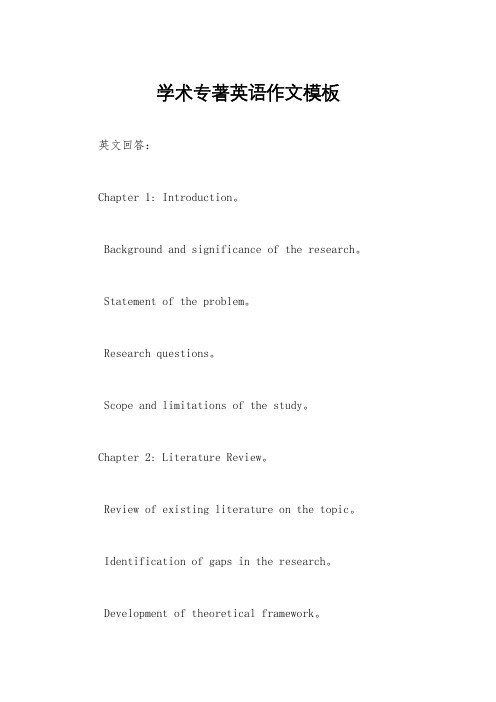
学术专著英语作文模板英文回答:Chapter 1: Introduction。
Background and significance of the research。
Statement of the problem。
Research questions。
Scope and limitations of the study。
Chapter 2: Literature Review。
Review of existing literature on the topic。
Identification of gaps in the research。
Development of theoretical framework。
Chapter 3: Methodology。
Description of the research design。
Sampling strategy and sample characteristics。
Data collection methods。
Data analysis techniques。
Chapter 4: Results。
Presentation and analysis of the research findings。
Discussion of the key findings。
Chapter 5: Discussion。
Interpretation of the research findings。
Implications for theory and practice。
Recommendations for future research。
Chapter 6: Conclusion。
Summary of the research findings。
Restatement of the research questions。
Concluding remarks。
英语专业学术论文阅读与写作-文献综述-格式要求
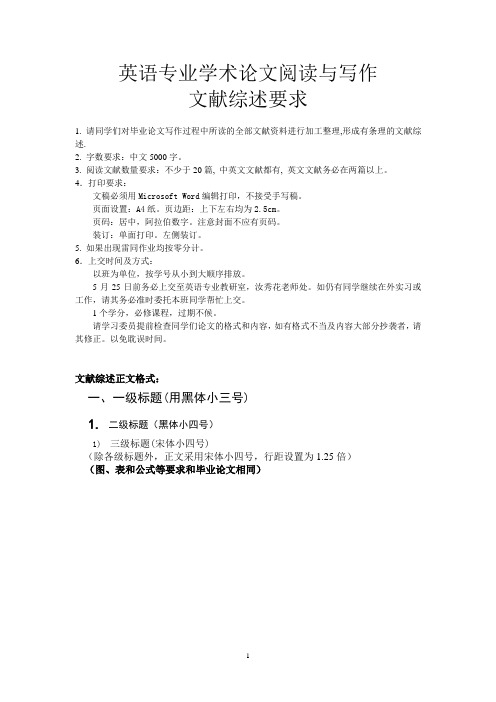
英语专业学术论文阅读与写作文献综述要求1. 请同学们对毕业论文写作过程中所读的全部文献资料进行加工整理,形成有条理的文献综述.2. 字数要求:中文5000字。
3. 阅读文献数量要求:不少于20篇, 中英文文献都有, 英文文献务必在两篇以上。
4.打印要求:文稿必须用Microsoft Word编辑打印,不接受手写稿。
页面设置:A4纸。
页边距:上下左右均为2.5cm。
页码:居中,阿拉伯数字。
注意封面不应有页码。
装订:单面打印。
左侧装订。
5. 如果出现雷同作业均按零分计。
6.上交时间及方式:以班为单位,按学号从小到大顺序排放。
5月25日前务必上交至英语专业教研室,汝秀花老师处。
如仍有同学继续在外实习或工作,请其务必准时委托本班同学帮忙上交。
1个学分,必修课程,过期不候。
请学习委员提前检查同学们论文的格式和内容,如有格式不当及内容大部分抄袭者,请其修正。
以免耽误时间。
文献综述正文格式:一、一级标题(用黑体小三号)1. 二级标题(黑体小四号)1) 三级标题(宋体小四号)(除各级标题外,正文采用宋体小四号,行距设置为1.25倍)(图、表和公式等要求和毕业论文相同)应该如何撰写文献综述?一、什么是文献综述1、文献综述的概念文献综述是对某一学科、专业或专题的大量文献进行整理筛选、分析研究和综合提炼而成的一种学术论文,是高度浓缩的文献产品。
根据其涉及的内容范围不同,综述可分为综合性综述和专题性综述两种类型。
所谓综合性综述是以一个学科或专业为对象,而专题性综述则是以一个论题为对象的。
文献综述反映当前某一领域中某分支学科或重要专题的历史现状、最新进展、学术见解和建议,它往往能反映出有关问题的新动态、新趋势、新水平、新原理和新技术等等。
文献综述是针对某一研究领域分析和描述前人已经做了哪些工作,进展到何程度,要求对国内外相关研究的动态、前沿性问题做出较详细的综述,并提供参考文献。
作者一般不在其中发表个人见解和建议,也不做任何评论,只是客观概括地反映事实。
- 1、下载文档前请自行甄别文档内容的完整性,平台不提供额外的编辑、内容补充、找答案等附加服务。
- 2、"仅部分预览"的文档,不可在线预览部分如存在完整性等问题,可反馈申请退款(可完整预览的文档不适用该条件!)。
- 3、如文档侵犯您的权益,请联系客服反馈,我们会尽快为您处理(人工客服工作时间:9:00-18:30)。
题目:用解析的方法估算围岩的自稳时间。
1.What is stand-up time?
Stand-up time is defined as the amount of time a tunnel will support itself without any added support structures, which means also the time that the rock mass around the tunnel begin to collapse(倒塌).
公式:
Here is what the stand-up time means.
There are some major factors.
t f is the stand-up time in years; Mrj is combined the influence of compressive strength (抗压强度)(rcj) of rock mass and tangent modulus (切线模量) (Etj) of rock mass(divide 除):Su is the effective span (有效跨度) in meters; po is the in-situ stress (原地应力)in t/m2 and usp is the seepage pressure(渗透压力) in t/m2. ks is the constant(常量) linked to Mrj
Fig2
Let’s see what’s the active span L means
Here is the tunnel face and this is the length of the excavation part. And this shows the L is shorter than the B and this shows the L is longer than the B. And what does this means? OK the next fig will tell us. Fig1
The X-axis means the stand-up time and the Y-axis means the Active span L. And we can see in this fig. With the increasing length of the active span the stand-up time decreased. And the letter A B C D means different kinds of rock mass. And we will explain them later.
2.Rock mass classification methods(围岩分级方法)
Fig 3
OK the first one is the Q-system. The X-axis means the stand-up time and the Y-axis means the unsupported span(无支护跨度)。
And we can see five different kinds of rock here. And the Q is bigger and the Stand-up time is longger.
Fig4
OK the second one is RMR-system. The X-axis means the stand-up time and the Y-axis means the roof span(顶板跨度)。
We can see in this fig that the RMR-system’s results are just like the Q-system’s results. They are in the same shape and same magnitude(量级)。
3.Rock mass model(建立模型)
Fig5
Here is the mechanical model(力学模型) for tunnel excavation(隧道开挖). Here is the ground surface. And the depth of the tunnel is H. And the tunnel is in a homogeneous(均匀的) isotropic(各向同性的) rock mass. The tunnel is subjected to (受到)a uniform hydrostatic stress field(静水压力)(@。
) And internal(内压力) pressure(Po) uniformly (一致的)acts on the tunnel wall surface.
Fig6
OK,let’s see how the depth influences the stand-up time of the tunnel. The X-axis means the stand-up time and the Y-axis means the unsupported span(无支护跨度)。
Here are five different tunnel depths. The results indicate that the impact of(影响) the tunnel depth on the stand-up time of tunnel. The stand-up time decreases with increasing the tunnel depth. Therefore, the stand-up time for the deeper tunnel is shorter than that of shallow(埋深浅的) tunnel.
Table5
The table shows the rock mass properties. The siltstones(砂泥岩) are in there different Young’s modulus(杨氏模量). They are 6.2,14.0 and 23.5 GPa, that means poor, fair and good rock mass.
Fig7
And the fig shows how the Young’s modulus influences the stand-up time of the tunnel. The result indicates that the stand-up time is greater in the good rock mass quality in comparison with fair and poor rock mass qualities.
4.Result
Estimation(估计) of stand-up time of the rock mass is to have great meaningful in the selection of excavation methods as well as methods for rock reinforcement(围岩加固) in the most effective way possible. Question
How many Rock mass classification methods have been involved in this paper? What are they?
Two. The Q-system and the RMR-system.
How does the the depth influence the stand-up time of the tunnel?
The stand-up time decreases with increasing the tunnel depth. Therefore, the stand-up time for the deeper tunnel is shorter than that of shallow(埋
深浅的) tunnel.。
